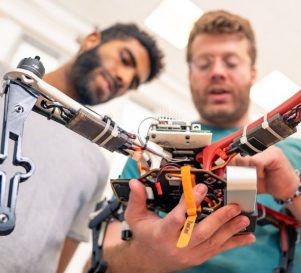In this talk the flight software containing the GNC algorithms for a low-cost research missile will be presented. The research missile will be employed as a recoverable testbed for the integration and evaluation of advanced flight algorithms. This reusability is intended to reduce the cost of flight test, and the overall cost of each test asset is contained by utilizing commercial off-the-shelf avionics in the missile. An effective missile test platform is both reliable and recoverable, such that it can be reused for subsequent flight testing. The missile configuration and proposed GNC algorithms were designed to achieve these objectives. The flight software is comprised of four modules: guidance, navigation, control, and flight logic. The proposed control architecture is that of a skid-to-turn missile, such that the missile tracks vertical and horizontal acceleration commands Az and Ay while regulating the roll angle phi to zero. The guidance algorithm generates the Az, Ay and phi commands for executing desired trajectory. The flight logic defines the phases of flight along the trajectory and contains algorithms for detecting the transition events including launch, main engine cutoff, apogee, and recovery. The flight software and missile performance are evaluated using 6DOF simulations and Monte Carlo analyses. The code is then compiled and implemented on the Pixhawk flight computer and tested by Processor-in-the-Loop and Hardware-in-the-Loop simulations.

In this talk the flight software containing the GNC algorithms for a low-cost research missile will be presented. The research missile will be employed as a recoverable testbed for the integration and evaluation of advanced flight algorithms. This reusability is intended to reduce the cost of flight test, and the overall cost of each test asset is contained by utilizing commercial off-the-shelf avionics in the missile. An effective missile test platform is both reliable and recoverable, such that it can be reused for subsequent flight testing. The missile configuration and proposed GNC algorithms were designed to achieve these objectives. The flight software is comprised of four modules: guidance, navigation, control, and flight logic. The proposed control architecture is that of a skid-to-turn missile, such that the missile tracks vertical and horizontal acceleration commands Az and Ay while regulating the roll angle phi to zero. The guidance algorithm generates the Az, Ay and phi commands for executing desired trajectory. The flight logic defines the phases of flight along the trajectory and contains algorithms for detecting the transition events including launch, main engine cutoff, apogee, and recovery. The flight software and missile performance are evaluated using 6DOF simulations and Monte Carlo analyses. The code is then compiled and implemented on the Pixhawk flight computer and tested by Processor-in-the-Loop and Hardware-in-the-Loop simulations.
"*" indicates required fields









